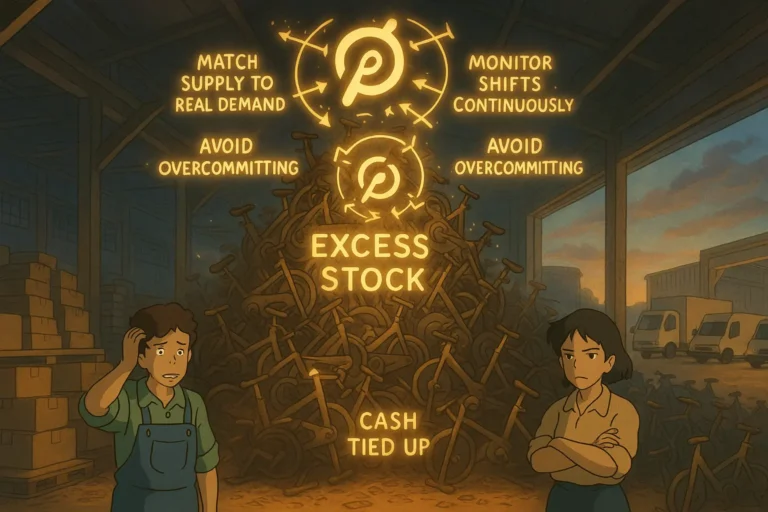
Overstocking is an inventory challenge that is quite common in many African supply chains. It is primarily the result of a poor demand forecasting structure and a lack of understanding of the customer.
Your customers are the primary focus of your supply chain. When they are not properly considered in the demand planning, it could lead to a rejection of the entire process.
In this article, we will explore the realities of overstocking and how African supply chains can better manage it.
What is Overstocking?
Overstocking is an inventory situation that occurs when there is too much inventory moving into the warehouse but not enough leaving. It is when the supply chain has too much inventory on its hand.
Overstocking is the opposite of a stockout when the supply chain runs out of stock. There are two extremes for supply chains, each with their own challenges.
The major challenge with overstocking is that it ties down cash in holding costs. The inventory holding cost is more than just the product cost. It is also the cost of storage, insurance, security, etc. You can imagine how the cost will stack up when there is too much inventory.
What are Some of the Causes of Overstocking in African Supply Chains
Here, we highlight some common causes of overstocking for supply chains across Africa.
𝟭. 𝗦𝘂𝗽𝗽𝗹𝗶𝗲𝗿 𝗹𝗲𝗮𝗱 𝘁𝗶𝗺𝗲 𝘃𝗮𝗿𝗶𝗮𝗯𝗶𝗹𝗶𝘁𝘆: The supply chain believes the suppliers cannot arrive on time with the goods, so they order from another supplier to bridge the gap. The problem occurs when the supplier arrives on time, leaving the inventory department with excess product.
𝟮. 𝗜𝗻𝗮𝗰𝗰𝘂𝗿𝗮𝘁𝗲 𝗗𝗲𝗺𝗮𝗻𝗱 𝗙𝗼𝗿𝗲𝗰𝗮𝘀𝘁𝗶𝗻𝗴: The supply chain believes the market has a certain demand for its product and plans accordingly. But then the market performs lower than expected. This miss in demand forecasting can leave the supply chain holding a lot of unwanted inventory.
𝟯. 𝗣𝗼𝗼𝗿 𝗖𝗼𝗺𝗺𝘂𝗻𝗶𝗰𝗮𝘁𝗶𝗼𝗻: The supply chain might be quite on point, but poor communication between stakeholders and other departments quickly leads to overstocking or stockouts because of wrong data processing.
𝟰. 𝗗𝗲𝗮𝗱 𝗦𝘁𝗼𝗰𝗸𝘀, 𝗢𝗯𝘀𝗼𝗹𝗲𝘁𝗲, 𝗼𝗿 𝗙𝗼𝗿𝗴𝗼𝘁𝘁𝗲𝗻 𝗦𝘁𝗼𝗰𝗸𝘀: These products are one of the major contributors to the overstocking. They take up excess space in the warehouse and, in many cases, take up expenses as well. Read all about dead stocks here
How African Supply Chains Can Manage Overstocking
African supply chains can leverage these strategies to tackle the issue of overstocking in their inventory.
1. Adopt More Robust Demand Planning and Forecasting System
As much as supply chains want to produce, they must produce what their customers want. Anything else will lead to market rejection. A very good demand planning and forecasting infrastructure can mitigate this.
Using the DPFS, the supply chain can better understand its customers and tweak the product to ensure it is what the market wants. They can also use the system to determine the quantity the supply chain is willing to buy or engage with.
This way, it saves the supply chain unnecessary costs in holding inventory. However, the supply chains in Africa are always weary about the initial cost implications of installing one. However, considering the cost savings it entails, it is, in many cases, a no-brainer.
2. Simplify Communication
Communication is very important in the supply chains. It helps facilitate the flow of information between all stakeholders, departments, and processes. Many times, the supply chain might be doing great with demand forecasting but then may have issues communicating the result.
The issue could impact suppliers and their delivery to the supply chain. It could also impact the procurement and production team, leading to more than necessary inventory.
It is important to encourage the flow of information between parties in the supply chain. But more than that, this information has to be communicated in real-time to prevent mistakes. When it comes in too late, it is typically unable to change much.
A significant investment must be made in establishing appropriate communication channels to simplify communication and make it more effective in the supply chain.
3. Consider Switching Inventory Management Method
One of the major causes of overstocking is the inventory strategy or method in use. Many supply chains use the push inventory style in a market favouring the pull inventory. Some are using pull instead of the just-in-time inventory style.
Knowing the right inventory style or strategy can significantly reduce overstocking for these supply chains. But it starts by observing the industry and the nature of the product.
For instance, an aeroplane manufacturer will not suddenly start producing planes in bulk when there are no orders. This is because aeroplanes are expensive to assemble, but the demands are few and far between.
That is, they are pulled from the market. Keeping them doesn’t do that manufacturer any good. On the other hand, a phone manufacturer can use the push inventory style because the product is pushed to the market for customers to decide.
Knowing the right inventory strategy goes a long way to determining the success of that inventory.
4. Consider Sourcing Locally
Although sourcing globally has its draws, and don’t get me wrong, they are worth it. The problem is that international sourcing is usually over huge distances, which could mean delays, disruptions, or downtimes for these supply chains.
To prevent these, the supply chains order much more than needed to bridge the delay gap. However, this is where they get into problems.
This is because when there is a fluctuation in demand, these supply chains are left holding much more inventory than initially anticipated.
But there is another option on the table. The supply chains can onboard and partner with local suppliers instead of ordering too much inventory to bridge that delay gap. That way, the supply chains do not incur costs when the market is experiencing a downturn.
Impacts of Overstocking in African Supply Chains
Explore the ways overstocking can impact supply chains across Africa.
𝟭. 𝗜𝗻𝗰𝗿𝗲𝗮𝘀𝗲𝗱 𝗛𝗼𝗹𝗱𝗶𝗻𝗴 𝗖𝗼𝘀𝘁: Overstocking results in increased holding costs and a demand for more warehouse space. This takes the working capital that may be allocated to other supply chain endeavours.
𝟮. 𝗕𝘂𝗱𝗴𝗲𝘁 𝗖𝗼𝗻𝘀𝘁𝗿𝗮𝗶𝗻𝘁𝘀: Too much inventory swallows up money that could be spent elsewhere. This births budget constraints and may make it more difficult for a business to exploit expansion prospects or deal with unforeseen difficulties.
𝟯. 𝗗𝗲𝗰𝗹𝗶𝗻𝗶𝗻𝗴 𝗽𝗿𝗼𝗳𝗶𝘁 𝗺𝗮𝗿𝗴𝗶𝗻𝘀 𝗮𝗻𝗱 𝗶𝗻𝗰𝗿𝗲𝗮𝘀𝗲𝗱 𝗱𝗶𝘀𝗰𝗼𝘂𝗻𝘁𝗶𝗻𝗴: Businesses may use discounts or promotions to eliminate excess inventory, which lowers profit margins. This affects the supply chain’s overall financial situation.
𝟰. 𝗗𝗶𝗺𝗶𝗻𝗶𝘀𝗵𝗲𝗱 𝗔𝗱𝗮𝗽𝘁𝗮𝗯𝗶𝗹𝗶𝘁𝘆 𝗮𝗻𝗱 𝗙𝗹𝗲𝘅𝗶𝗯𝗶𝗹𝗶𝘁𝘆: Overstocking can hurt a supply chain’s capacity to adjust to shifting market dynamics, consumer preferences, or outside disruptions. This lack of adaptability in changing marketplaces can make the supply chain less competitive.
𝟱. 𝗦𝘁𝗿𝗮𝗶𝗻𝗲𝗱 𝗦𝘂𝗽𝗽𝗹𝗶𝗲𝗿 𝗥𝗲𝗹𝗮𝘁𝗶𝗼𝗻𝘀𝗵𝗶𝗽: Relationships with suppliers may suffer if overstocking leads to order cancellations or modifications. This strain may affect future agreements and negotiations.
Overstocking in African Supply Chains – FAQs
Q1: In a constantly changing market, how can supply chains in Africa handle issues connected to overstocking?
Supply Chains in Africa should prioritize developing an agile and adaptable corporate culture, adopting correct inventory policies, strengthening communication, and increasing supply chain visibility to solve overstocking-related issues in a dynamic market.
Additionally crucial are timely modifications to inventory strategy and routine evaluations of market conditions.
Q2: In African marketplaces, how does overstocking affect customer satisfaction?
In African markets, overstocking can harm consumer satisfaction because it can cause order fulfilment delays, possible stockouts of popular products, and the need for steep discounts to eliminate extra inventory.
Customers may find it more difficult to obtain the things they want as a result, and the brand’s reputation may suffer.
Q3: What are the best ways for African supply chains to manage their inventory levels to avoid stockouts and overstocking?
Supply chains in Africa can achieve optimal inventory levels through technology for inventory management, efficient demand forecasting, well-defined lines of communication throughout the supply chain, and a well-rounded safety stock policy.
It’s also critical to conduct regular assessments and modifications based on consumer input and market trends.
Q4: How might substantial overstocking in African supply chains affect the economy?
Pervasive overstocking in African supply chains may negatively affect the economy, including ineffective resource allocation, lowered company competitiveness, and slowed economic expansion.
It could also worsen environmental problems and waste levels, affecting how sustainable the corporate ecosystem is.

Obinabo Tochukwu Tabansi is a supply chain digital writer (Content writer & Ghostwriter) helping professionals and business owners across Africa learn from real-world supply chain wins and setbacks and apply proven strategies to their own operations. He also crafts social content for logistics and supply chain companies, turning their solutions and insights into engaging posts that drive visibility and trust.








